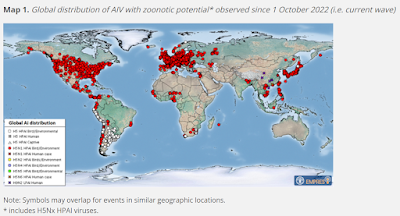#17,583
If you only went by the officially reported outbreaks of avian flu (as depicted on the FAO map above), you'd probably conclude that HPAI H5 was almost exclusively an American and European problem. Most of Africa and the Middle East are devoid of reports, as is the bulk of South America.
Similarly, Russia and China are nearly blank slates as well.
But the truth is, HPAI H5 has spread globally, sparing (for the time being) only Australia/NZ, parts of Oceania, and Antarctica. The above map doesn't represent so much where H5N1 is, rather it represents which countries are willing (or able) to report it.
For South America and Africa, much of this dearth in reporting is likely due to the remote nature of their interiors, and a lack of surveillance, testing, and reporting capabilities. But in other places - particularly the Middle East, Russia, and China - the silence is intentional.
Prior to the Arab Spring revolution of 2011 and the subsequent political turmoil, we had pretty good access to outbreak information from the Middle East. But since then, the flow of real-time information has nearly stopped (see Revisiting Egypt’s Murky H5N1 Battle).It wasn't always so.
We still hear about occasional human infections with H5N6, H9N2, and H3N8, but often only months after the fact, and with minimal details offered.
Date: 2023-07-28
On July 28, the Ministry of Agriculture and Rural Affairs received a report from the Chinese Center for Animal Disease Prevention and Control that an outbreak of highly pathogenic avian influenza of the H5N1 subtype of wild poultry occurred in Nagqu City, Tibet Autonomous Region, with 5,182 wild birds including wild brown-headed gulls and other wild birds dying, and no poultry households within 3 kilometers of the epidemic site.
After the outbreak of the epidemic, the local area immediately carried out emergency treatment in accordance with the provisions of the emergency implementation plan, carried out harmless treatment of all sick and dead wild birds, and carried out investigation, blockade and sanitize of the surrounding environment, and strictly prohibited personnel and livestock and poultry from entering the epidemic control area.
Although Chinese State media (and their MOA) carries frequent reports on H5Nx, they are invariably about outbreaks in other countries, only rarely about domestic events.
Still, we know from many published studies (see a sampling below) by Chinese researchers that avian flu viruses are abundant in China's bird population.
One Health: H10Nx Avian Influenza Viruses Detected in Wild Birds in China Pose Potential Threat to Mammals
Characterization of an Emergent Chicken H3N8 Influenza Virus in Southern China: a Potential Threat to Public Health
EID Journal: Evolution of Avian Influenza Virus (H3) with Spillover into Humans, China
Study: Global Dissemination of Avian H5N1 Clade 2.3.4.4b Viruses and Biologic Analysis Of Chinese Variants
I've no idea why the MOA decided to report on the Tibet outbreak, but it is probably too much to hope that China is easing up on their policy of `radio silence' about avian flu.
If anything, this tactic of official silence - or slow-rolling the release of information - seems to be growing around the globe. (see Flying Blind In The Viral Storm).
Despite long-standing international agreements requiring immediate notification of zoonotic disease threats, most countries are either still unable - or simply unwilling - to comply (see Lancet Preprint: National Surveillance for Novel Diseases - A Systematic Analysis of 195 Countries).
Policies that leave the world unnecessarily vulnerable to the next global health crisis.

